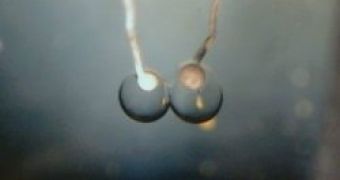Light sensors come in many shapes and sizes, and are also called photodetectors. Some of the most known examples are photocells, photodiodes and phototransistors, which are usually quantum devices in which an individual photon produces a discrete effect.
Now, a team of scientists at Oxford University and Duke University in the United States has created one of the smallest and simplest photodetectors using milimeter-sized water droplets and hair-thin electrodes.
This light sensor transforms the water droplets into protocells, artificial cells voided of their biological content, that can be filled with different cellular components. In theory, networks of protocells could be used to simulate biological systems - such as heart muscle or brain tissue.
"Each millimetre-sized water droplet in our network acts as a protocell. Chains of droplets are put together like liquid Lego, and are just as easily taken apart or reorganized," said Dr Matthew Holden of Oxford University's Department of Chemistry who conducted the research with Oxford's Professor Hagan Bayley and Professor David Needham at Duke University.
They used a protein, bacteriorhodopsin, that bacteria use to produce energy, and introduced it into a network of tiny droplets. This creates a positive electric charge when reacting to green light, a process that pumps protons across the membrane of a cell.
Electrodes as thick as a human hair were then introduced in the droplets to measure this current, with the help of a sensitive amplifier. One of the possible applications of this technique is an artificial eye, which could see droplets arranged to form pixel in an imaging array.
"Using protocells to simulate biological systems offers significant advantages to working with live cells, where there is far less control over their contents, size and function,' said Dr Holden. 'Many living cells do not survive outside a narrow temperature range and are extremely sensitive to environmental conditions, such as pH. In the long run protocell-based systems could reduce the cost and complexity of biological experiments and, in some cases, might be used in place of animal testing."

 14 DAY TRIAL //
14 DAY TRIAL //